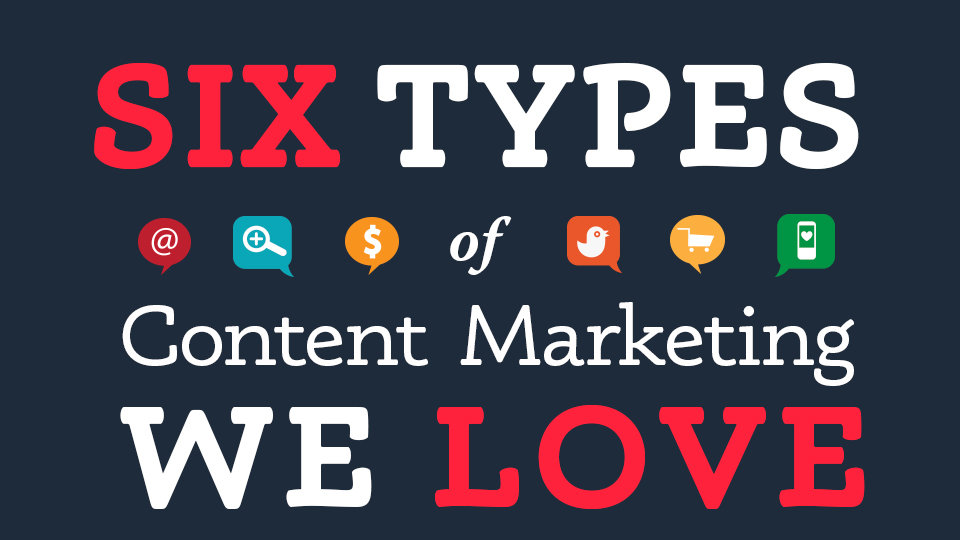Six Types of Content Marketing We Love
By Kristen Shoates
Content marketing is all the rage today, and for good reason. In an advertising saturated world, it’s a way to cut through the clutter, to build relationships with your audience and show your expertise. From Dove’s Campaign for Real Beauty to Coke’s Share a Coke campaign, to free webinars and downloads, more and more organizations are creating and distributing content that engages audiences, provides resources and reinforces their brand.
But not all content is created alike. There are various types of content marketing, and understanding the difference can help you decide what is best for your organization. Here are six types of content we’re loving right now:
1) Storytelling
Storytelling content involves collecting and distributing stories that reinforce your brand or organization’s purpose. While these are sometimes case studies, they can often go deeper, reinforcing some of the emotional elements of your brand. Who’s doing it well?
- Southwest Airlines: Their brand’s whole focus is on heart and people. Rather than just talk about low fares and boarding procedures, they use their magazine, emails, social media and other marketing channels to tell stories of how Southwest comes alongside travelers to help them out, surprise them or just do something fun, like an inflight concert. The stories they tell reinforce the “heart” behind their brand.
- Lyft: What started as an opportunity for neighbors to help each other out by ridesharing, Lyft has become a tech giant, offering alternatives to traditional taxis in most major American cities. Now that it’s a large corporation, Lyft still maintains their core community value through charitable partnerships and hiring drivers willing to go the extra mile. On their blog, they highlight these partnerships, spotlight drivers who helped out riders, and tell stories of how they are empowering drivers who are making their dreams come true through their Lyft income.
2) Related Resources
While almost all content marketing is centered around releasing content that provides resources to customers, the “related resource” content piece is designed to help people use your product better, either directly or by complementing your product. For example, Whole Foods uses their site and email newsletters to send out seasonal recipes to help shoppers create better meals out of the Whole Foods food products. Airbnb, the travel app that allows people to rent out their homes and apartments, creates city guides so their travelers can better explore and choose a place to stay. The related resource is less about providing training for your product and more about providing content that enhances the user’s experience with your product through complementary information.
3) Freebies With The Upsell
While many organizations are nervous to give away too much, providing pieces of content at no charge leads to sales down the road. The reason is two-fold: 1) it gets people loving and trusting the content you offer, making them want more and 2) it creates a sense of reciprocity, making people want to buy from you for helping them out for free. We’ve seen personal trainers post free YouTube and downloadable workouts to encourage the purchase of their DVDs, nutrition plans and other products. Authors give away free chapters, e-Books or old titles in advance of a new book release. Musicians offer free album downloads to encourage ticket and merch sales. You get the picture.
The bottom line: the reaping and sowing principle holds true in marketing, and you’ll get back what you give.
4) Curated Content
As someone who knows your industry best, sometimes the best way you can resource your customers is to help them navigate the myriad of content and products available to them. Organizations, especially those that aggregate content, can help curate information for users, positioning the organization as the go-to for whatever product they offer and keeping users returning over and over. For example, Spotify creates playlists around moods, genres and events, as well as sending out information about weekly new releases and other additions to the music streaming platform. Fashion brands create lookbooks and themed collections, helping shoppers not just purchase clothes but style them.
5) Affinity Marketing
Though it’s similar to related resources, affinity marketing is even broader, providing content that doesn’t necessarily relate to the product but instead relates to the buyer. For example, clothing companies such as Anthropologie and Free People recognize that they are lifestyle brands and their shoppers are interested in travel, adventure, music and art. Their blogs focus more on these topics than on clothes, making the clothes an accessory for the life their customer strives to live. Outdoor brands do the same thing, focusing on topics such as exploration and the environment rather than just gear. Christian nonprofits might send out daily devotionals, building trust with potential donors who then support the cause. Affinity marketing requires a deep understanding of your audience, which in turn lets you powerfully become a part of their lives.
6) Thought Leadership
Used by businesses and consultants, thought leadership is about sharing expertise and insight from those who work in an industry everyday. For example, MailChimp creates downloadable guides on email marketing best practices. A bank might create an article about wise financial investing. On this blog, we share insight into marketing and technology trends and best practices, based on our daily experience as a MarTech agency. The goal of thought leadership is to share knowledge among industries and build trust, so if someone needs a service you offer, they know you know what you’re talking about.
The next time you develop a content strategy, don’t just think about format – blog post, email, webinar – but think about the type of content you’re offering your audience. Figure out what best enhances your organization’s brand and product or service, and switch it up at times to keep your audience interested.
What types of content have worked best for your organization? Which are your favorite types of content to receive?














